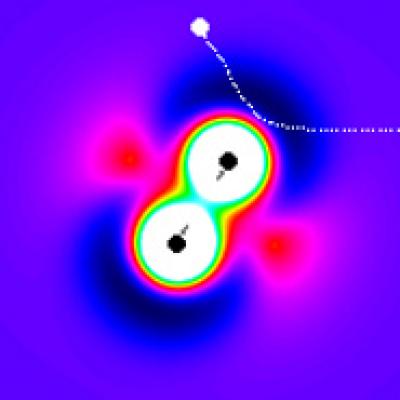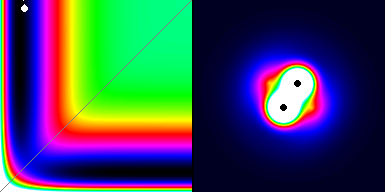We all know what happens when cars collide on the freeway or an anvil lands on Wile E. Coyote's head - physics at the macro level is predictable. But what about a single hydrogen atom and a lone molecule of deuterium, the smallest atom and one of the smallest molecules?
When an atom collides with a molecule, traditional wisdom said the atom had to strike one end of the molecule hard to deliver energy to it. People thought a glancing blow from an atom would be useless in terms of energy transfer, but that turns out not to be the case, according to the researchers.
Every atom or molecule, even if it has no charge, has electrostatic forces around it-sort of like the magnetic field of the Earth. Those chemical forces exert a pull on any other atom or molecule within range, trying to form a chemical bond.

"We have a new understanding of how energy can be transferred in collisions at the molecular scale," said Richard Zare, a professor of chemistry at Stanford University and senior author of a paper presenting the results in the July 3 issue of Nature.
What Zare and his team found is that a speeding hydrogen atom does not have to score a direct hit on a deuterium molecule, a form of molecular hydrogen made up of two heavy isotopes of hydrogen, to set the molecule vibrating. It only needs to pass closely enough to exert its tiny chemical force on the molecule. Vibrating molecules matter because they are more energized, making them more reactive. Thus, energy transfer effectively softens them up for future reactions.
"This has changed a very simple idea that we cherished-that to make a molecule highly vibrationally excited, you basically had to crush it, squeeze it, hit it over the head. Compress some bond and the molecule would snap back," Zare said. "We found quite the opposite."
One could compare it to the difference between a punch in the stomach and a caress on the cheek. Both can set the senses tingling, but in very different fashions.
Zare's team discovered that as a hydrogen atom passed close to a deuterium molecule, the chemical forces tugged on the nearest of the deuterium atoms in the molecule, pulling it away from the other deuterium atom. But if the tug was not strong enough to break the two deuterium atoms apart, as the hydrogen atom moved farther away its hold on the deuterium atom would weaken. The deuterium atom would eventually slip from its grip and snap back toward the other deuterium atom, initiating an oscillation, or vibration.

Left: PES in molecular coordinates: H-D vs D-D bond distance [0.4 .. 3.8 Å] at current H-D-D bending angle.
Right: PES in space-fixed Cartesian coordinates: potential as function of (x,y) coordinate of H atom (white circle) at current (fixed) positions of both D atoms (black circles) [−2.8 .. +2.8 Å].
"What we are really seeing is the result of a frustrated chemical reaction," Zare said. "The molecule wants to react. It just didn't get into the right position with the right conditions so that it could react."
Zare went on to picture this process as follows: "The deuterium molecule is in a happily married state until the hydrogen atom flies by and attracts the nearest deuterium atom. This deuterium atom in the middle is in a giant tug of war. It is being fought over by two lovers, two highly similar atoms that are both attracted to the middle deuterium atom. This affair is a love triangle. In energy transfer, the original spouse wins out. The middle deuterium atom decides not to stray and rebounds to the other deuterium atom-its first love-setting both to vibrate rapidly."
The new findings may have ramifications for understanding what happens in any chemical reaction, in addition to interactions between chemicals that do not result in a reaction but instead result in energy transfer. So far, one instance has been discovered, but Zare believes that this behavior is likely to be found in many other collision systems.
"This is very fundamental stuff as to what happens in transformations of matter from one state to another," Zare said. "It's very fundamental chemistry."
Comparing the ramifications of the new findings to a ripple spreading out from a pebble dropped into a pond, Zare said, "Maybe this will be the sound of one hand clapping, if the ripple doesn't go anywhere. Taken together, the only way we advance is making these ripples and following them as they spread outward."
Zare's group did the experiments that revealed the energy transfer occurring during "soft" collisions between the hydrogen atom and the deuterium molecule by using techniques and equipment for measuring the molecular interactions that had previously been developed in his laboratory. The experimental work is a major portion of the doctoral thesis of his graduate student Noah T. Goldberg, who was assisted in these measurements by Jianyang Zhang, a postdoctoral researcher, and graduate student Daniel J. Miller.
The theoretical calculations that provided the model used to explain the observations is the result of work done by co-authors Stuart Greaves of the University of Bristol and Eckart Wrede of the University of Durham, both in Britain.
Article: Vibrational excitation through tug-of-war inelastic collisions, by Stuart J. Greaves, Eckart Wrede, Noah T. Goldberg, Jianyang Zhang, Daniel J. Miller & Richard N. Zare. Nature, 3 July, Vol 454, p. 88.





Comments